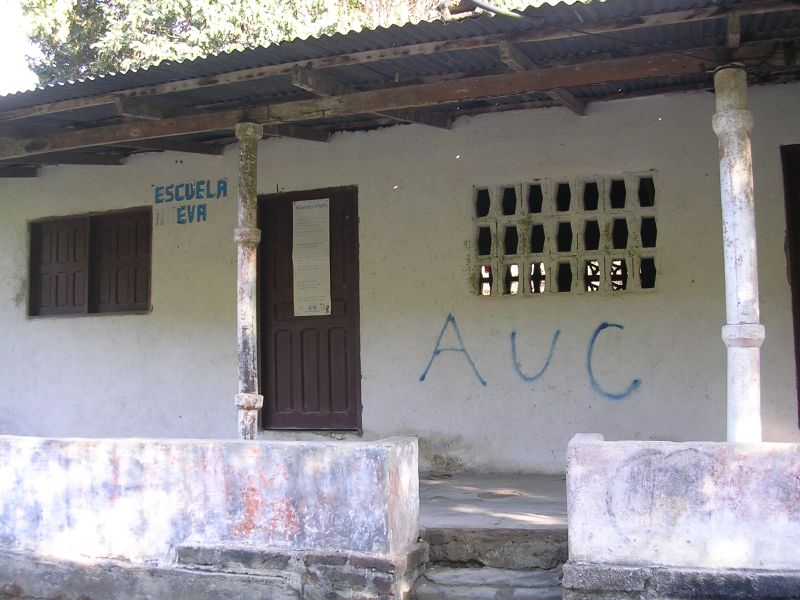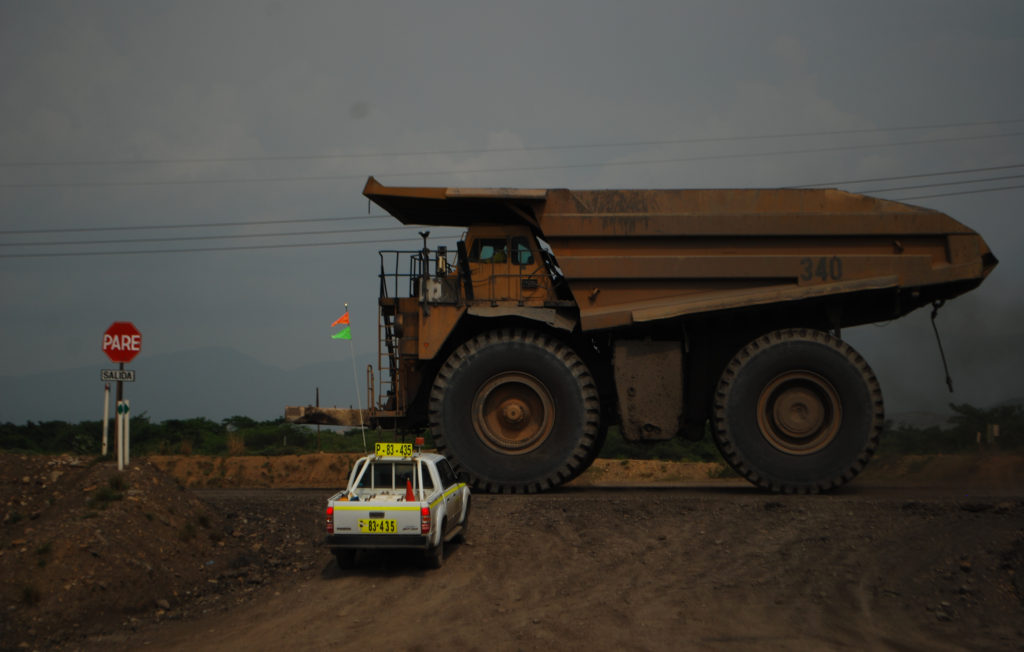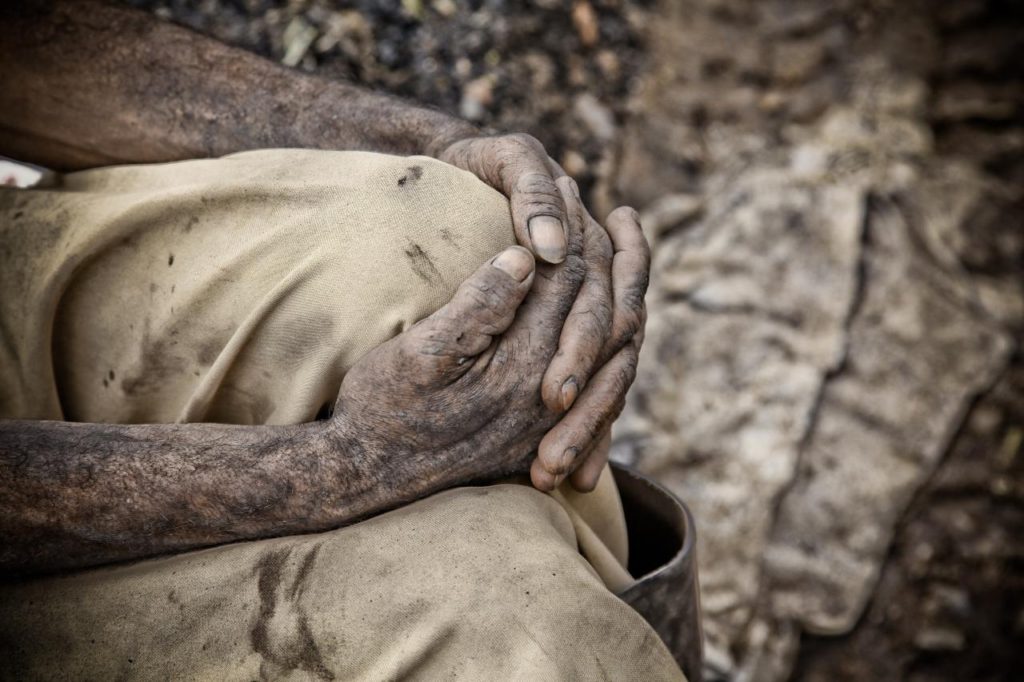Originally published at MintPress News.
AUSTIN, Texas — On Thursday, Colombia’s Congress ratified a new peace accord that could end decades of civil war and weaken the ability of foreign corporations to turn a profit on unrest in the South American country.
Since the 1960s, communist rebel forces have fought right-wing paramilitary groups and their government allies in Colombia’s ongoing civil war. While the paramilitary groups ostensibly formed in opposition to communist groups like the Revolutionary Armed Forces of Colombia, or FARC, their targets were more often the civilian and indigenous population.
The Colombian government reported in November that more than half a century of armed conflict has left 7,011,027 people displaced, 267,000 murdered, and 46,000 “disappeared.”
Throughout the decades of conflict, massive international businesses have been eager to take advantage of the paramilitary groups’ skills to suit their own interests and move into land formerly occupied by displaced people. Some of the numerous foreign corporations accused of serious human rights abuses in Colombia include fruit companies Dole, Del Monte, and Chiquita, agribusiness giant Cargill, and other representatives of the fossil fuel industry like Texaco (formerly Texas Petroleum Company) and Exxon Mobil.
Heeding corporate orders, paramilitary groups murdered union and labor rights activists, tortured and terrorized countless indigenous and Afro-Colombian people, and devastated entire villages of subsistence farmers to make way for mining, fossil fuel extraction, or plantations that would bring massive profits to foreign corporations. The Colombian military — and, in at least one high-profile massacre, the U.S. military — sometimes lent a hand in these human rights crimes.
“Every human rights person I work with in Colombia believes the peace process is a necessary precondition” to ending corporate exploitation of Colombia, Dan Kovalik, a human rights and labor rights lawyer who teaches at the University of Pittsburgh School of Law, told MintPress News.
In addition to studying South American politics and human rights since the 1980s, Kovalik has been involved in several human rights lawsuits on behalf of Colombians abused by massive corporations.
Under the peace process, he said, “The hope is that the military, freed up from fighting the FARC, will turn their guns against the paramilitaries.”
Even so, there are concerns that the peace process won’t go far enough to dismantle the powerful paramilitary groups that so many international corporations have used as personal armies in the region.

Chiquita stokes years of violence with weapons & support for paramilitaries
Historically, Washington and Bogotá have maintained cordial relations, but the Cold War and the war on drugs brought the two nations even closer in the 20th century. That cozy relationship enabled massive foreign corporations to exploit Colombian resources and the country’s labor force, and the flow of foreign capital into the country has helped fuel decades of civil war.
In court, “Chiquita admitted to paying paramilitaries and giving them 3,000 Kalashnikov rifles between 1997 and 2004,” Kovalik said.
Chiquita allied with the United Auto-Defense Forces of Colombia (AUC), one of the country’s most violent paramilitary groups, Steven Cohen noted in a report for ThinkProgress in 2014. The AUC, a group once designated as a terrorist group by the U.S. government, is responsible for thousands of deaths in Colombia. It turns out that Chiquita had been playing both sides of the conflict. Cohen reported:
By its own account, Chiquita made at least 100 payments — $1.7 million in total — to the AUC between 1997 and 2004. In the decade prior to that, the company had maintained a similar arrangement with the Revolutionary Armed Forces of Colombia (FARC), the nominally leftist rebel group chased out of the region by the combined (and coordinated) efforts of the AUC and Colombian military.
“There’s been some recent reports that [Chiquita’s funding of paramilitaries] may have continued until very recently through a subsidiary,” Kovalik added.
While these allegations remain unproven in court, they do suggest a staggering number of victims. Multiple lawsuits were consolidated in 2011, accusing Chiquita of being involved in the killings of as many as 4,000 Colombian nationals.
While the evidence is clearest in the case of Chiquita, other international banana growers are suspect as well. “According to Salvatore Mancuso, a high-ranking paramilitarian in U.S. prison, Dole and Del Monte also worked with the paramilitaries,” Kovalik said. “All the banana companies have.”
Mancuso is currently serving a 15-year sentence in a federal prison and has been spoken openly about the influence thatcorporations like Chiquita hold in Colombia.
Watch “Chiquita support to paramilitary groups:”
The influence of banana growers in Colombia pre-dates the ongoing civil war. In 1928, the Colombian government brutally shut down a strike by United Fruit Company banana pickers under threat from the U.S. government. Some estimates put the death toll from the military action as high as 2,000, including workers, women and children.
United Fruit was once one of the most powerful corporations in the world, manipulating the governments and economies of multiple Latin American countries. Chiquita was a trademark of United Fruit until 1990, when the company renamed itself Chiquita Brands International in an effort to rehabilitate its image. (Chiquita was purchased by two Brazilian companies in 2015, and is now headquartered in Switzerland.)
‘The Coca-Cola Case’
“It should be noted under the peace agreement, at least the one that went down in October, Coca-Cola was one of the companies named [that will be] subjected to further investigation for paramilitary ties,” Kovalik said.
Coca-Cola, or at least its Colombian bottlers, have also been linked to paramilitary groups and human rights abuses. The bottlers and the company’s Atlanta headquarters have faced multiple lawsuits over attacks on union organizers.
A 2010 documentary, “The Coca-Cola Case,” focused on the soda giant’s role in turning Colombia into the “trade union murder capital of the world,” June Chua wrote in a review for Rabble.ca that year.
Chua wrote:
The documentary splits its time nicely between two battles: the court fight waged by Daniel Kovalik, lawyer for the United Steelworkers union, on behalf of [Colombian] union members, and the public awareness crusade of Ray Rogers, who directed the Campaign to Stop Killer Coke.
Coca-Cola was accused of multiple murders, Chua noted:
Overriding the case are the chilling facts. Between 1990 and 2002, 10 union leaders connected to Coke workers were murdered. Kovalik and the union believe paramilitaries hired by the pop drink’s bottlers are responsible for the killings.
Ultimately, however, the company escaped legal consequences. Kovalik explained:
We did sue them and in a court of law we were unable to tie the Atlanta company in with what was happening on the ground. It still matters if franchises down there were doing this stuff.

Mining & fossil fuel companies bring murder & pollution to Colombia
Colombia is rich with resources that foreign corporations are eager to exploit, particularly in the mining, agriculture, and biofuels industries.
“Mining is probably the biggest threat now to indigenous people, Afro-Colombians and peasants, and will continue to be as the peace agreement goes forward,” Kovalik added.
Justin Podur, an author and global political analyst, told MintPress that Colombian human rights activists frequently say that “displacement in Colombia is not a side effect of the war, it’s really the point of the war.” Whether by design or coincidence, decades of unrest created fertile ground for profit.
Podur has traveled to Colombia multiple times and maintains contacts in the country’s social justice movements.
According to Podur, subsistence farmers and other impoverished residents of small villages have suffered most under the decades of conflict. American and multinational corporations have proven eager to take advantage of that displacement to replace small farms with massive plantations. Mining and fossil fuel companies, using a similar strategy to agricultural and fruit companies, frequently moved into areas emptied by the displacement of the civil war.
“[Colombia]’s a massive, incredibly wealthy country, and it’s in this region that happens to be the U.S. backyard in which independent development hasn’t really been allowed to take place,” Podur said.
Podur, who lives in the Toronto area, noted that Canadian and multinational corporations based outside the United Statesare also involved in manipulating South American politics for profit, but U.S. trade with Colombia far outpaces the amount invested by most other countries. For example, in Canada, two-way trade (both imports and exports) with Colombia totaled about $1.6 billion in 2015. By August of this year, two-way trade between the United States and Colombia had already exceeded $17.5 billion.
Podur said:
Canadian mining plays a huge role in Colombia and elsewhere in Latin America. It’s definitely transnational capital, but the U.S. footprint is there and it’s special.
In many ways, he suggested, the U.S. government’s treatment of Colombia is reflective of its general colonialist attitude toward South America.
“There’s always been this tension in every Latin American country between a local agenda of national independent development and the imposition of an economic model that’s favorable to [the United States],” Podur said.
In one of the most shocking examples of fossil fuel companies supporting the death and displacement of Colombian people, Kovalik highlighted the “the Santo Domingo massacre, in which Occidental Petroleum were part of an operation to bomb the Santo Domingo community.”
In a 2005 article for Z Net on the massacre, Kovalik and Luis Galvis explained:
On December 13, 1998, in what has become one of the most notorious war crimes in Colombia, the hamlet of Santo Domingo was attacked by a U.S. cluster bomb from a Colombian Air Force helicopter. Seventeen civilians, including 7 children, were killed as a result of the bombing.
In 2002, the Los Angeles Times revealed that the bombing had actually been carried out at the behest of, and with the assistance of, the Houston-based oil company which had its headquarters in Los Angeles at the time.
Times staff writer T. Christian Miller wrote:
Los Angeles-based Occidental Petroleum, which runs an oil complex 30 miles north of Santo Domingo, provided crucial assistance to the operation. It supplied, directly or through contractors, troop transportation, planning facilities and fuel to Colombian military aircraft, including the helicopter crew accused of dropping the bomb.
And, earlier this year, Gilberto Torres, a Colombian union activist, sued BP in London. He alleges that in 2002, he was kidnapped and tortured for 42 days by paramilitaries who were following orders from the oil giant.
Other effects of mining and oil and gas exploration are more subtle, but just as pernicious.
“One of the most notorious mining companies is AngloGold Ashanti, which is a South African concern,” Kovalik said. “They’ve been devastating to the ecosystem and the indigenous people, particularly in the Chocó region.”
The Chocó Department in Western Colombia is known for its high percentage of Afro-Colombian and indigenous residents. In 2013, hundreds in Colombians marched against expansion of AngloGold Ashanti mining concerns, but to little avail. Kovalik said:
Along with other mining companies, they’ve polluted the water there that’s critical to the livelihoods of people. If you fly over the Chocó, you can see the mercury floating on the waters from the gold mining operations.

‘The war has really done its work’
“There’s no secret document that says we’re going to displace all these people for the sake of these corporations, but if there were a deliberate plan for corporate takeover it would look a lot like what we’ve seen over the past few decades,” Podur said.
Podur said he believes that most corporations and the U.S. government support peace in Colombia because there’s little to be gained from continued unrest. He added:
In the negotiations there are these peasant zones and there’s some land reform built into the peace accord, but it’s not nearly what’s been lost in terms of peasant lands in the last two decades. From that elite perspective, the war has really done its work.
At the same time, the Colombian military and defense industry, which Podur described as “totally subordinate” to the U.S. military-industrial complex, does stand to profit from continued conflict. He added:
Colombian soldiers are all over Latin America training others in counterinsurgency. There’s a vested interest in Colombia being a place where weapons are battle tested.
Kovalik is optimistic that life will improve for Colombia’s most vulnerable.
“The peace process does require the government to consult with the indigenous people and Afro-Colombians before their land can be used for mining and other extractive industries. That’s an advance,” he said.
Further, he noted, a cessation in hostilities may give Colombia’s delicate ecosystem, and the people who depend on it, the chance to recover.
There’s also the risk that the peace process could actually trigger more killing. In the 1980s, thousands of former rebels and peace activists were killed in the aftermath of a previous peace deal.
Including all the civil war’s victims from the dead to the displaced, Amnesty International estimates some 8 million Colombians have suffered over the last 50 years of fighting. While the NGO celebrated the signing of the peace process in a Dec. 1 statement, officials also warned that the damage of the civil war won’t be remedied overnight.
“The terrible legacy of these violations and the entrenched impunity for most of them means that, despite the peace agreement, many seemingly intractable conflict-related human rights and humanitarian challenges persist, and there is a real risk that these challenges will continue in a post-conflict environment,” said Erika Guevara-Rosas, Americas director at Amnesty.
Kovalik agreed that the future of Colombia hinges on the government’s ability to implement the deal.
“Under the agreement, the government has agreed to go after the paramilitaries,” he said. “Hopefully that will happen, but that remains to be seen.”